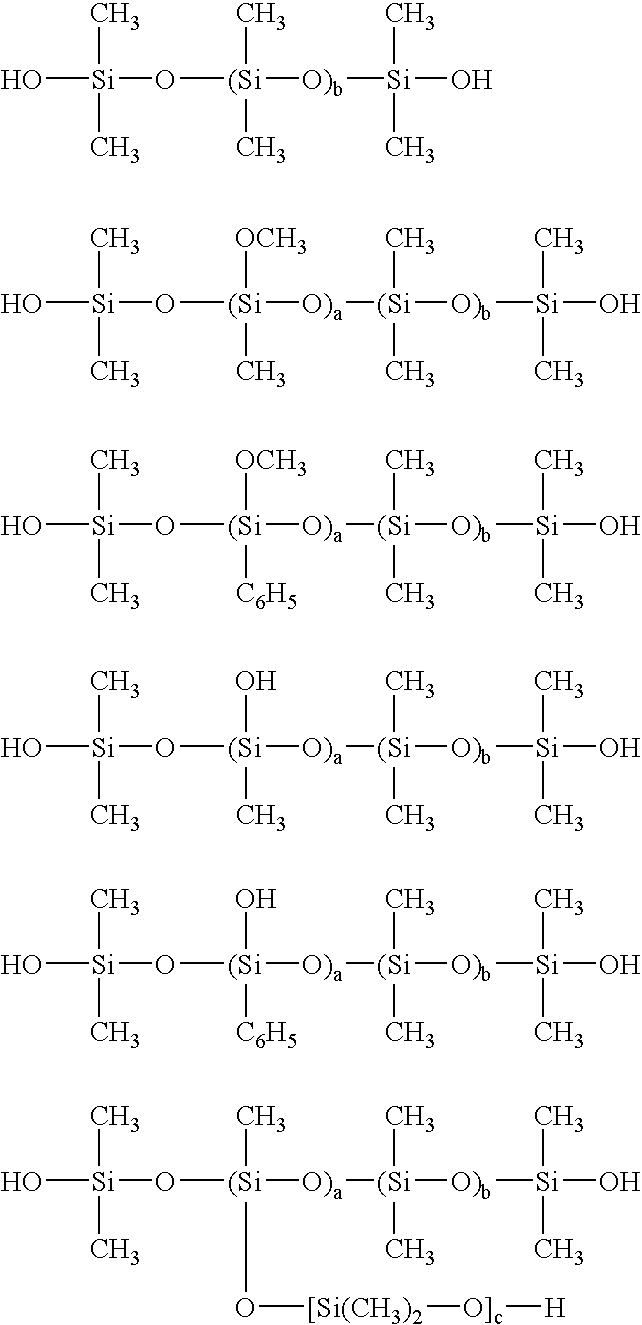Wood modified with silicone emulsion composition
- Summary
- Abstract
- Description
- Claims
- Application Information
AI Technical Summary
Benefits of technology
Problems solved by technology
Method used
Image
Examples
preparation example 1
[0046] A 2-L polyethylene beaker was charged with 498 g of octamethylcyclotetrasiloxane, 2 g of triethoxyphenylsilane, 50 g of 10% sodium laurylsulfate aqueous solution and 50 g of 10% dodecylbenzenesulfonate aqueous solution, which were homogeneously emulsified using a homomixer. Water, 400 g, was slowly added for dilution, and the diluted liquid passed twice through a high-pressure homogenizer under a pressure of 300 kg / cm2, yielding a homogeneous white emulsion. This emulsion was transferred to a 2-L glass flask equipped with a stirrer, thermometer and reflux condenser, where it was subjected to polymerization reaction at 50° C. for 24 hours, and aging at 10° C. for 24 hours. This was followed by neutralization to pH 6.2 with 12 g of 10% sodium carbonate aqueous solution. The emulsion thus obtained had a nonvolatile content of 45.4% upon drying at 105° C. for 3 hours, and contained a non-flowing, soft gel-like organopolysiloxane having an average composition represented by [(CH3)...
preparation example 2
[0047] A 2-L polyethylene beaker was charged with 500 g of octamethylcyclotetrasiloxane, 50 g of 10% sodium laurylsulfate aqueous solution and 50 g of 10% dodecylbenzenesulfonate aqueous solution, which were homogeneously emulsified using a homomixer. Water, 400 g, was slowly added for dilution, and the diluted liquid passed twice through a high-pressure homogenizer under a pressure of 300 kg / cm2, yielding a homogeneous white emulsion. This emulsion was transferred to a 2-L glass flask equipped with a stirrer, thermometer and reflux condenser, where it was subjected to polymerization reaction at 50° C. for 24 hours, and aging at 10° C. for 24 hours. This was followed by neutralization to pH 6.2 with 12 g of 10% sodium carbonate aqueous solution. The emulsion thus obtained had a nonvolatile content of 45.5% upon drying at 105° C. for 3 hours, and contained a gum-like organopolysiloxane of the formula HO—[(CH3)2SiO]n—H having a viscosity of at least 1,000 Pa·s at 25° C. In this way, a...
preparation example 3
[0048] Maleic anhydride, 154 g, was dissolved in 500 g-of ethanol, after which 346 g of 3-aminopropyltriethoxysilane was added dropwise at room temperature over one hour. Reaction was performed under ethanol reflux at 80° C. for 24 hours, yielding a pale yellow clear solution [B-1] containing 50% of component (B). This solution had a nonvolatile content of 45.1% upon drying at 105° C. for 3 hours. The reaction product in the solution consisted of about 60% of a mixture of (C2H5O)3SiC3H6—NHCO—CH═CHCOOH and (C2H5O)3SiC3H6NH3+−OCOCH═CHCOOC2H5 and the remainder (about 40%) of oligomers derived therefrom, as analyzed by IR, GC, NMR and GCMS.
PUM
| Property | Measurement | Unit |
|---|---|---|
| Percent by mass | aaaaa | aaaaa |
| Percent by mass | aaaaa | aaaaa |
| Percent by mass | aaaaa | aaaaa |
Abstract
Description
Claims
Application Information
 Login to view more
Login to view more - R&D Engineer
- R&D Manager
- IP Professional
- Industry Leading Data Capabilities
- Powerful AI technology
- Patent DNA Extraction
Browse by: Latest US Patents, China's latest patents, Technical Efficacy Thesaurus, Application Domain, Technology Topic.
© 2024 PatSnap. All rights reserved.Legal|Privacy policy|Modern Slavery Act Transparency Statement|Sitemap



